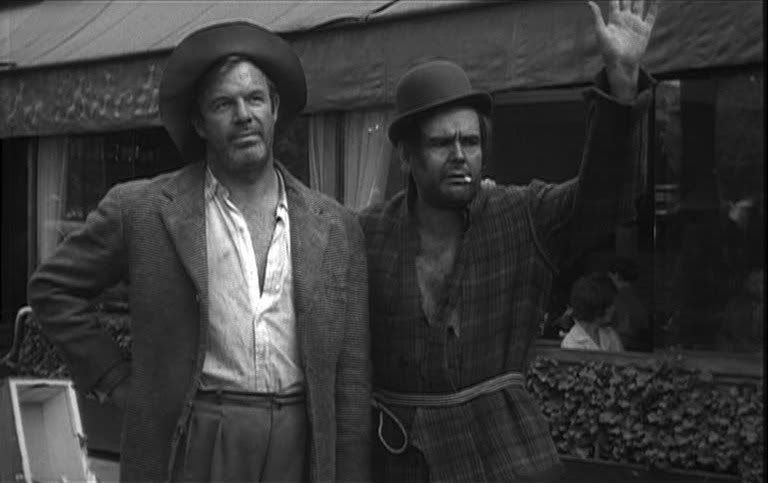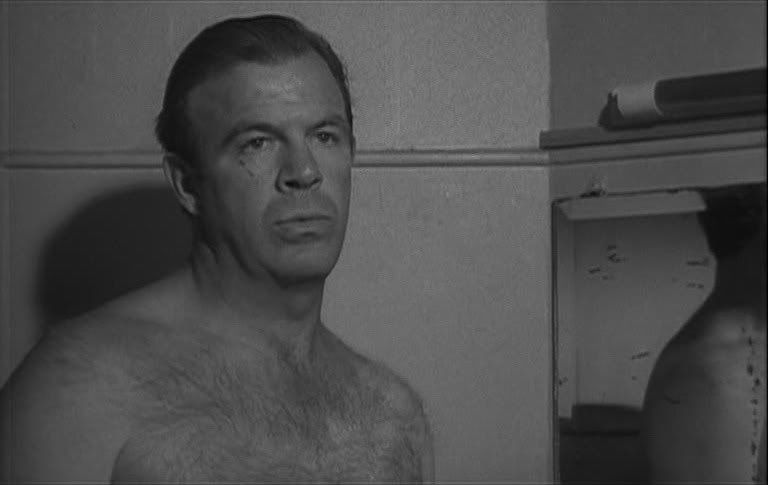
Eric Rohmer's debut film, The Sign of Leo, is very different from the films Rohmer would later become known for. The director who would soon enough be acclaimed for his philosophical examinations of love and morality, with protagonists constantly talking, talking, talking, debuted with a film that contains only traces of his later style. His protagonist, the transplanted American Pierre Wesselrin (Jess Hahn), is not prone to self-analysis and philosophical inquiry as later Rohmer heroes and heroines would almost invariably be. Pierre is blustery and boisterous, a hard-living man always on the edge of poverty, relying on the generosity of his friends to keep him afloat as he stumbles through life, drinking and partying. When he learns that he's acquired an inheritance from a rich aunt, he arranges a lavish party to celebrate, liberally borrowing money and uncaring that he's getting kicked out of his apartment, thinking he's wonderfully lucky. But the inheritance doesn't come through after all, and Pierre finds himself suddenly adrift in Paris, without a home, with all his old friends either away or dodging him, as his constant need for money begins to wear on them.
The film is aesthetically quite distinct from Rohmer's later work. Its rough, realistic portrait of Paris' streets seems descended from the work of Rohmer's idol Jean Renoir, particularly the downtrodden hero, who's a more melancholy variant on Renoir's Boudu. Much of the film is dedicated to following Pierre as he wanders around Paris, trying to find friends, moving from one hotel to the next, gradually losing or squandering all his possessions, becoming increasingly desperate from one luckless day to the next. Unlike in later films, when Rohmer would forsake non-diegetic music, much of these wanderings are set to a constant soundtrack of violin music, a mournful accompaniment to Pierre's desperation. For a director who would later turn his attention almost exclusively to the materially comfortable middle and upper classes and their romantic travails, Rohmer here has a sharp eye for the details of poverty and deprivation. The mostly dialogue-free scenes of Pierre on the streets are very perceptively observed: Pierre watching as a pair of bums are humiliated while begging at a café; Pierre listening in on the casual chatter of people who don't have to worry about food or money in any real way; Pierre trying to shoplift from a market and getting beaten up. It's harrowing and stark, and has few parallels in Rohmer's later work; the ostentatious mood-setting music is the opposite of what Rohmer would strive for in later films, while the near-total lack of dialogue is a stark contrast to Rohmer's later commitment to probing character through what's said, and not said, in the midst of their inevitable searches for love.
Love, of course, is far from Pierre's mind, and his girlfriend Cathy (Jill Olivier) disappears from the film without ceremony after the opening party segment. The film shows how luxuries like love are stripped away when life is reduced to a certain baseline level, where food, money and shelter are the primary concerns. Pierre's disintegration is heartrending, and to some extent it's so affecting precisely because it's contrasted against the usual Rohmerian milieu glimpsed at the beginning of the film, in which love affairs are the most important problems facing these characters. The party scene provides the foundation for the rest of the film, for Pierre's fall. He's a musician, playing the violin at the party but unable to complete his composition, and the piece he plays here will be repeated throughout the film, a motif that continually evokes the moment when Pierre thought he was on top of the world, before it all came crashing down on him. The music, though uncharacteristically direct in its emotional shadings for Rohmer, is used inventively, appearing sporadically in the diegesis as well as separately on the soundtrack. At the party, Rohmer's New Wave colleague Jean-Luc Godard makes an appearance as a silent partygoer who camps out next to the record player, obsessively looping a record of classical music so it keeps playing the same segment over and over again; his careful, ritualistic gestures have the quality of comic mime. Later, music will appear on radios, or played by bums on the street, and then be taken up on the soundtrack as Pierre makes his lonely treks around Paris.

The soundtrack is also notable for the way it makes dialogue an incidental element, fading in and out as Pierre wanders silently by groups of chatting friends and young people out enjoying the summer weather. Trapped in his misery and isolation, to Pierre these people sound shallow and shrill in their happiness. At one point, he mocks a pair of young girls derisively, mimicking their excited talk with chirping noises. Several times, Pierre sits on a bench and listens to the unconcerned talk of the people nearby, who can afford to be cavalier about money and food, who have petty troubles like bosses, medical benefits, travel expenses, where to go for vacation. He passes two lovers by the riverside who are kissing and feeding one another, and it looks decadent, sensual, lurid to the starved Pierre.
Finally, after some time on the streets, Pierre takes up with another bum (Jean Le Poulain), whose comic antics bring some life back into the film but also further Pierre's humiliation, making him a street performer, an unwilling sidekick in the bum's theatrical begging routine. The bum wheels Pierre through the streets in a wheelbarrow and performs opera in haphazard drag, and his revelry is like an absurd parody of Pierre's enthusiasm at the beginning of the film, his celebration and sense of play. Again, the film seems to be nodding to Michel Simon as Boudu, the bold comic type, the clown, outrageous and confrontational, shameless in his degeneracy.
The film goes through several distinct modes, then, the styles of its disparate sections deliberately clashing against one another: there's the broad introductory party, then the increasingly stark and neorealist segment of Pierre wandering the streets, which gives way to a more comic sensibility when the performing bum is introduced. This sets the stage for the rather pat and unconvincing ending, in which Pierre is abruptly whisked away from his desolate life on the streets by the return of his friends Jean-François (Van Doude) and Dominique (Michèle Girardon who, interestingly, bridges the gap between the French New Wave and their American hero Howard Hawks; a few years later Girardon would appear in Hawks' Hatari!). The film's ending suggests that the poverty and desperation of the middle section could be overcome by luck, by stumbling unwittingly into fortune, and it has the effect of making Pierre's bleak period seem like merely a bad dream, forgotten in the morning. Seen as an introduction to the rest of Rohmer's career, it's as though he's dispensing with the treatment of the lower classes by having his hero descend into poverty only to be rescued from it as in a fairy tale; from then on, there'd be little enough trace of class consciousness in Rohmer's films. Not that there needed to be, of course; there have been few better documenters of romantic questing and moral/philosophical introspection than Rohmer, who truly found his subject once he began probing the inner lives of the middle class. This first film, then, is interesting as an anomaly, as a sign of what might've been, in which Rohmer is still working through the influence of Renoir, perhaps grappling a bit with neorealism as well. What's present already, in this first film, is the director's strong eye for detail, his feel for building character through setting and gesture, and above all, his deep love of people, with all their foibles and troubles, all their failings and idiosyncrasies.

3 comments:
A rarely seen an truly interesting debut film -- for the reasosn you outlined. Its commercial failure put Rohmer's career on hold for many years, until the "comeback" of La Collectionneuse followed by the international success of Ma Nuit Chez Maud. By then he had adpoted a simpler production style than the one used for this film.
Jess Han's performance here is most interesting in relation to his work for Jean-Pierre Melvile.
Ah, as much as I love Rohmer, this is one that has eluded me. I had no idea his debut feature differed so much from what would come to be his signature style. The earliest Rohmer I've seen is The Bakery Girl of Monceau which I love, and of course stars Barbet Schroeder as one of the archetypal Rohmer heroes. I think that was made only a few years after The Sign of Leo, so it's really interesting to me that he was working in a much different area with this one. The Renoir echoes are especially interesting.
Needless to say, awesome review Ed. Rohmer was truly one of the greats, and this piece has me incredibly anxious to give this a watch, and catch up on some of his earlier stuff I still haven't seen.
Thanks, David and Drew.
Drew, it's very much worth seeing for Rohmer fans. As David says, the film's commercial failure discouraged Rohmer and led to a break from filmmaking of several years, in which he rethought things. That's why, when he returned with the first two short Moral Tales and then La Collectionneuse, his style was quite different. It's not like he's unrecognizable in his debut, but it's certainly a side of him that's not nearly as prominent in his later features.
Post a Comment